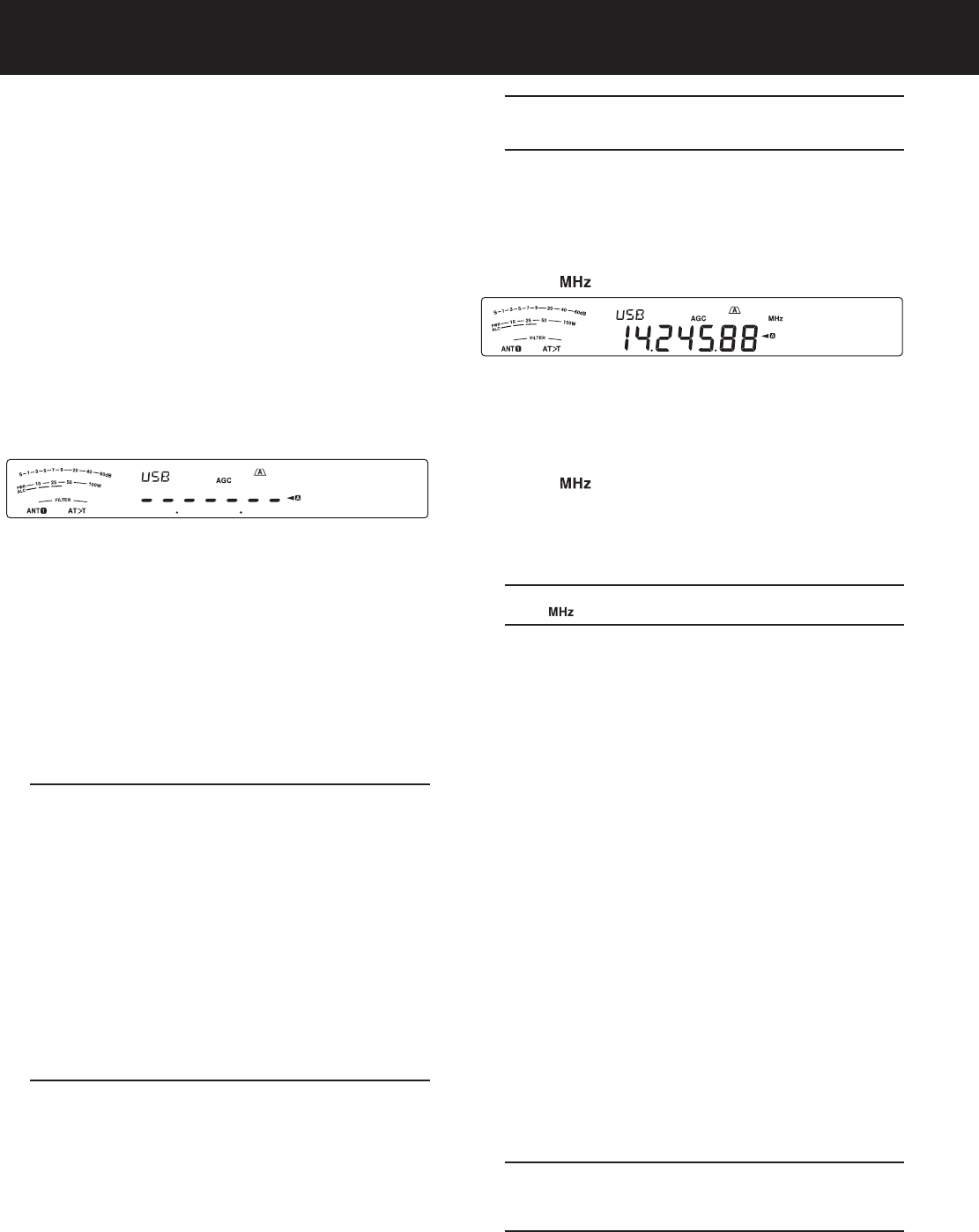
&20081,&$7,1*$,'6
28
5(&(37,21
6(/(&7,1*<285)5(48(1&<
In addition to turning the Tuning control or pressing
Mic [UP]/ [DWN], there are several other ways
to select your frequency. This section describes
additional methods of frequency selection that may
save you time and effort.
Q 'LUHFW)UHTXHQF\(QWU\
When the desired frequency is far removed from
the current frequency, directly entering a frequency
from the numeric keypad is usually the fastest
method.
1 Press [ENT].
• “ - - . - - - . - - ” appears.
2 Press the numeric keys ([50 (0)] to [28 (9)]) to
enter your desired frequency.
• Pressing
[ENT] at any time fills the
remaining digits (the digits you did not enter)
with 0 and completes the entry.
To select 1.85 MHz for example, press
[ENT], [50 (0)], [1.8 (1)], [24 (8)], [14 (5)],
then press [ENT] to complete the input (6
key strokes).
• Pressing
[CLR] before pressing [ENT]
cancels the entry and restores the current
VFO frequency.
Note:
X You can enter a frequency in the range of 30.00 kHz
to 59.999.99 MHz. Refer to the specifications for the
available frequency range.
X Attempting to enter a frequency that is outside the
selectable frequency range causes an alarm to sound
and the entered frequency is rejected.
X When the entered frequency does not meet the current
VFO frequency step size requirement, the nearest
available frequency is automatically selected after the
entered frequency is changed.
X When the 10 Hz digit (last displayed digit) is entered,
the digit 0 is automatically entered for the 1 Hz digit,
and frequency entry is completed. The 1 Hz digit is not
displayed.
X When an entered frequency is accepted, RIT or XIT will
be switched OFF, but the RIT or XIT offset frequency is
not cleared.
Q )UHTXHQF\(QWU\+LVWRU\
The last 10 frequencies you entered are stored in
the Frequency Entry History. You can access the
history to easily re-enter a recently used frequency.
1 Press [ENT].
2 Turn the MULTI/CH control.
• The entered frequency along with its log
number appears. The most recent entered
frequency is logged as number E0 and the
oldest frequency is logged as number E9.
3 Press [ENT] to set the selected frequency to
the VFO.
Note: When entering a frequency using the numeric
keys, if you turn the MULTI/CH control in the middle of the
frequency entry, the frequency will be entered into the log.
Q 8VLQJWKH0+]NH\
You can use the MULTI/CH control to change the
operating frequency in steps of 1 MHz.
1 Press [MHz].
•“
” appears.
2 Turn the MULTI/CH control.
• Clockwise increases the frequency and
counter-clockwise decreases the frequency.
3 Press [MHz] again to exit.
•“
” disappears.
If you prefer to change the frequency in steps of
100 kHz or 500 kHz, rather than 1 MHz, access
Menu No. 10 and select 100 kHz, 500 kHz, or
1 MHz.
Note: Even if 100 kHz or 500 kHz is assigned for the [MHz]
key, “ ” appears on the display.
Q 4XLFN46<
To move up or down the frequency quickly, use the
MULTI/CH control. Turning this control changes
the operating frequency in steps of 5 kHz for SSB/
CW/ FSK/ AM and steps of 10 kHz for FM.
• If you want to change the default frequency
step size, access Menu No. 14 (SSB/CW/FSK),
15 (AM), or 16 (FM). Press [M.IN]/ [SCAN (SG.
SEL)] to select 500 Hz, 1 kHz, 2.5 kHz, 5 kHz,
or 10 kHz for SSB/ CW/ FSK, and 5 kHz, 6.25
kHz, 10 kHz, 12.5 kHz, 15 kHz, 20 kHz, 25 kHz,
30 kHz, 50 kHz, or 100 kHz for AM/ FM. The
default frequency step size is 5 kHz for SSB/
CW/ FSK/ AM and 10 kHz for FM.
• When changing the operating frequency by
using the MULTI/CH control, frequencies
are rounded such that new frequencies are
multiples of the frequency step size. To disable
this function, access Menu No. 12 and select
“oFF” (default is ON).
• Within the AM broadcast band, the step size
automatically defaults to the frequency step
value in Menu No. 13. This frequency step size
can be switched between 9 kHz (“on”) and
5 kHz (“oFF”) via Menu No. 13.
Note: The programmed frequency step size for the
MULTI/CH control is stored independently for the HF and
50 MHz bands. You can also set a different frequency step
size for SSB/ CW/ FSK, AM and FM modes.
